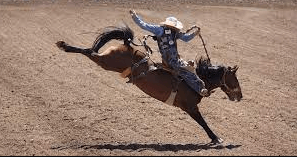What Are The Main Phases In Eventing?

Eventing, also known as the equestrian triathlon, is a challenging and exhilarating sport that tests both the horse and rider’s skills in three distinct phases.
These main phases include dressage, cross-country, and show jumping. Each phase requires a different set of abilities and techniques from the participants, showcasing their precision, stamina, and agility.
The first phase of eventing is dressage, which focuses on the precise execution of predetermined movements by the horse and rider. It requires harmony between them as they perform intricate maneuvers with grace and elegance. The aim of dressage is to demonstrate the horse’s obedience, suppleness, and responsiveness to subtle cues from the rider. It showcases their partnership as they execute movements such as circles, changes of direction, lateral work, and transitions between gaits. Dressage sets the foundation for success in eventing by developing communication and control between horse and rider.
The second phase of eventing is cross-country where competitors navigate an outdoor course filled with natural obstacles such as fences, water crossings, ditches, banks, and hills over a long distance at high speeds. This phase puts both physical ability and mental strategy to test as riders must make quick decisions while maintaining balance and control over their horses. Cross-country tests not only endurance but also bravery as riders must trust their horses’ instincts when approaching jumps or challenging terrain. It is a thrilling display of freedom as horse and rider conquer obstacles in a natural setting.
The final phase of eventing is show jumping which takes place in an arena with various brightly colored fences arranged in a specific pattern within a confined space. Show jumping emphasizes agility and accuracy as participants must navigate through technical courses within time limits without knocking down any rails or refusing any jumps. Precision becomes paramount here as riders must adjust stride lengths and take calculated turns while maintaining impulsion throughout the course. It is an exciting finale to eventing competitions that demands not only athleticism but also mental focus and quick thinking. Show jumping showcases the culmination of a horse and rider’s training as they demonstrate their skill in overcoming challenging combinations of jumps with speed, accuracy, and style.
In conclusion, eventing is a multifaceted sport that encompasses three main phases: dressage, cross-country, and show jumping. Each phase highlights different aspects of horsemanship and athleticism while offering an engaging spectacle for spectators. Whether it is the precision and grace of dressage, the stamina and bravery required for cross-country, or the thrilling finale of show jumping, eventing provides participants and audiences alike with an exciting and captivating experience.
Dressage: The Precision and Grace of Horse and Rider
Dressage, as an essential phase in eventing, showcases the harmonious and artful collaboration between horse and rider through meticulously executed movements and precise control.
The artistry of dressage lies in its impact on horse training, emphasizing the development of balance, suppleness, and obedience.
Through a series of intricate maneuvers such as lateral movements and collected gaits, dressage helps to strengthen the horse’s muscles and improve their overall athleticism.
Furthermore, dressage plays a crucial role in improving rider balance and coordination. By focusing on proper body alignment and subtle aids, riders develop a deep understanding of their own bodies while learning to communicate effectively with their equine partners.
This precision not only enhances the aesthetic appeal of the performance but also ensures safety for both horse and rider.
Overall, dressage serves as a foundation for eventing by fostering a strong partnership between horse and rider based on trust, communication, and skilled execution.
Cross-Country: Navigating Challenges and Testing Stamina
Cross-country, a challenging phase in eventing, requires riders to navigate various obstacles and test the stamina of both horse and rider.
Riders are faced with a range of challenges as they tackle the course, including natural elements such as water crossings, ditches, banks, and solid fences.
These obstacles demand precision and quick decision-making skills from the rider in order to successfully navigate them.
The physical demands of cross-country cannot be underestimated, as riders must have excellent fitness levels to endure the long distances and maintain control over their horse at high speeds.
Additionally, riders need to have a deep understanding of their horse’s capabilities and limitations in order to safely complete the course.
Cross-country is not only a test of skill but also an exhilarating experience that allows both horse and rider to demonstrate their courage and partnership as they conquer each challenge together.
Show Jumping: The Thrilling Finale
The final phase of eventing, show jumping, adds an element of thrill and excitement as riders navigate a course filled with brightly colored fences and technical challenges.
Show jumping is the culmination of the event and tests both the horse and rider’s skill, precision, and agility.
The jumps in this phase are typically made up of poles or rails that are designed to easily fall if touched by the horse. This requires riders to have precise control over their horses while maintaining a fast pace.
The adrenaline rush experienced during show jumping is unmatched as riders must make quick decisions and execute accurate jumps within a limited time frame.
Read also: What Are The Rules Of Eventing?
The combination of thrilling jumps, the speed at which they must be completed, and the pressure to perform well creates an electrifying atmosphere for both participants and spectators alike.
Frequently Asked Questions
What are the different levels or categories of eventing?
Different levels or categories of eventing include Beginner Novice, Novice, Training, Preliminary, Intermediate, and Advanced. Each level has specific requirements and obstacles that must be completed within a certain time frame. The scoring system is based on penalties incurred during the competition.
How are eventing competitions judged?
Eventing competitions are judged based on various criteria and scored using a system that evaluates the horse’s performance, rider’s skills, and overall execution. The judging criteria include accuracy, technique, style, dressage movements, jumping clear rounds, and time penalties incurred.
Are there any specific rules or regulations that participants must follow during eventing?
Participants in eventing must follow specific rules and regulations to ensure fair competition. These may include guidelines for dressage, show jumping, cross-country courses, equipment usage, horse welfare, and penalties for rule violations.
What kind of training is required for both horse and rider to excel in eventing?
Training requirements for both horse and rider in eventing are extensive. Horses must undergo rigorous training in dressage, cross-country jumping, and show jumping. Riders must develop balance, coordination, and knowledge of each phase to excel in the sport. Performance expectations demand precision and athleticism from both horse and rider.
What are some common challenges or obstacles that participants may encounter during the cross-country phase?
During the cross-country phase in eventing, participants face a challenging obstacle course that requires them to navigate over various jumps and natural obstacles. Time penalties may be incurred if they do not complete the course within the allotted time limit.
Conclusion
In conclusion, eventing consists of three main phases: dressage, cross-country, and show jumping.
Dressage showcases the precision and grace of both horse and rider as they perform a series of intricate movements with elegance and poise. The riders must demonstrate their ability to communicate effectively with their horses through subtle cues and commands, displaying a deep understanding of their partner.
The next phase, cross-country, presents a true test of stamina and bravery as horse and rider navigate through a course filled with challenging obstacles such as water jumps, ditches, and combinations. This phase requires immense trust between the pair as they tackle each obstacle with determination and skill.
Finally, show jumping brings the event to an exhilarating finale. Riders must guide their horses over a course of brightly colored fences within a set time limit. This phase demands accuracy, agility, and quick thinking from both horse and rider. The tension builds as each fence is cleared successfully or met with an unfortunate knockdown.
Overall, eventing is a captivating equestrian discipline that combines artistry, athleticism, and teamwork. It requires dedication from both horse and rider to excel in all three phases. Through the precision of dressage, the challenges of cross-country, and the excitement of show jumping – eventing truly embodies the harmonious partnership between humans and horses in pursuit of excellence.



